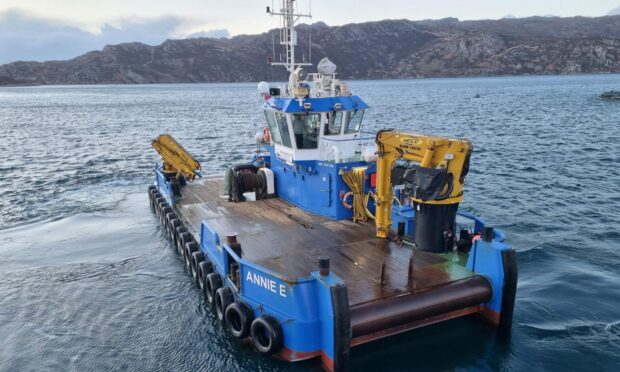A horror accident aboard a fish farm maintenance vessel has left a deckhand with life changing injuries.
However, the Marine Accident Investigation Board (MAIB) has made no recommendations following an inquiry into the accident that took place on April 3 2021.
The deckhand was aboard the Annie E around the Isle of Muck when he was seriously injured by a buoy that had been suspended in the air during a routine maintenance inspection.
Annie E is owned by Mallaig Marine Ltd, a company based in Mallaig.
Deckhand taken by helicopter to hospital
The buoy had been lifted 30ft into the air by a crane on the Annie E when it struck the deckhand.
The Annie E had travelled from Tobermory to the Isle of Muck on the day of the accident.
A report into the incident states that at approximately 1.15pm, a deckhand on board the workboat Annie E was injured.
He was struck by a grid buoy that had been lifted out of the water by the workboat’s forward crane at a fish farm off the Isle of Muck.
The report said: “Annie E’s skipper had noticed that the grid buoy was out of position and needed to be lifted in order to recover and re-lay its mooring anchor.
“The workboat’s forward crane was used to lift the buoy and its anchor connection out of the water.
“The buoy was suspended 30ft above the water when its metal components experienced a mechanical failure, resulting in the buoy falling and striking the deckhand.”
The crane operator lifted the deckhand to his feet and tried to help him walk to
Annie E’s accommodation on the main deck.
The deckhand collapsed after a few steps so the crane operator moved him to the shelter of the starboard bulwark.
The crane operator supported the deckhand, cut of his personal flotation device (PFD)
to enable him to breathe and applied a clean cloth to his head wound.
The skipper started to navigate Annie E at full speed toward Mallaig, which was two hours away.
By 1.24pm, the coastguard had tasked a helicopter and the Mallaig RNLI all-weather
lifeboat to Annie E and advised the skipper to rendezvous with them east of
the Isle of Eigg.
At 2.04pm the lifeboat was on scene. At 2.18pm the helicopter arrived and lowered the
winchman onto the vessel, which then went alongside Annie E.
The winchman and two lifeboat crew transferred across to attend to the deckhand and, following medical assessment and first aid treatment, the deckhand was put on a stretcher and winched into the helicopter.
He was taken to hospital where he underwent surgery. He has since received further surgery and treatment.
MAIB criticised the lifting of the grid buoy as it was was not “certified as lifting equipment”.
What were the safety issues?
The key safety issues identified were:
- The deckhand was injured when he was struck by a falling grid buoy that had been lifted by Annie E’s forward crane.
- The deckhand was standing near to the suspended buoy, contrary to the workboat owner’s risk assessments, method statements, lifting plan and industry guidelines.
- The risk assessments and method statements did not take away the risks associated with a suspended load.
- The grid buoy was not certified as lifting equipment and the lifting technique used did not comply with the manufacturer’s recommended procedure, which the vessel’s owner and crew were unaware of.
- The grid buoy’s metal components were worn and the top washer was missing, both of which resulted in its failure.
- There was no record of the buoy having been inspected before installation or routinely checked in accordance with manufacturer’s guidelines while in service.
The MAIB made no safety recommendations.


Conversation